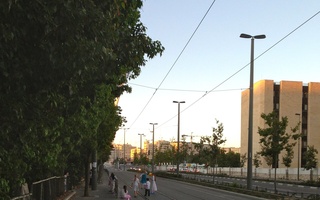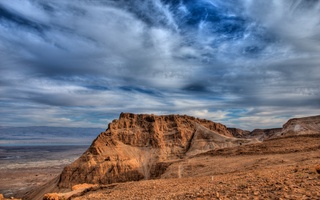JERUSALEM, Israel—We were standing on a precipice, the holiest city in the world sprawling down, up, and across the mountainous topography in front of us. A single shining golden dome demarcated the center—of the city, of monotheistic religion, of history, of everything.
Families and tour groups alike head to this lookout for one last glimpse at the city before heading to the airport. I imagine most Jews who visit the site on their way home mutter the promise to return, “next year in Jerusalem,” as they take their last look at the old city in the distance. I imagine that as they witness this final, breathtaking view, they really mean their words.
The day that I went to this lookout, the holy city was tainted. Just beyond the glittering Dome of the Rock, a thick cloud of black smoke, still billowing, cut across the cloudless blue sky. As our tour guide recited historical facts that I have heard time and time again—the 1948 UN partition, the Six Day War That Was Really Seven Days and the 1967 green line, the first intifada and the second—the sound of bullets ricocheted through the air. The tour guide told us not to worry. The bullets were made of rubber.
Unlike other Jews who visited the site, I couldn’t keep my eyes focused on this view of Jerusalem. I was compelled to keep reloading my Twitter feed to find out if anyone had died in the distance.
We walked away from the lookout as the smoke dissipated into the sky. We boarded the bus and found out from a news alert that three Palestinians had been killed by police in the Al-Aqsa protests that day. We woke up the next morning and found out that three Jews had been murdered by a Palestinian terrorist in a West Bank settlement overnight.
Next year in Jerusalem. These words are meant to bring hope to the Jews everywhere. But the scene unfolding in front of my eyes felt hopeless. The protests over security measures at Al-Aqsa have halted, but the conflict between Israelis and Palestinians continues, and the conflict over Jerusalem continues. Americans, ever the optimists, promise that every problem has a solution. But as I watched yet another conflict unfold in the old city, I felt my American optimism lose out to logic.
One speaker at a geopolitics conference I attended in Israel remarked that Jerusalem could never be divided, unless, he sarcastically added, the border was at the Kotel. In grim jest, he pointed out perhaps the most insurmountable issue of indivisibility in human history: that the old city, only 0.35 square miles, cannot possibly be bargained for or divided.
I had naively thought that being in Israel would illuminate the answer to the Israeli-Palestinian conflict, and prove to me which side is more right—as if there were such a thing—and what the solution should be. But instead of adding clarity, each day here has revealed another complexity.
Anna M. Kuritzkes ’20, a Crimson editorial and news editor, lives in Pforzheimer House.Read more in Opinion
Home(less) at HarvardRecommended Articles
-
HIPAC Wants Embassy MovedThe Harvard Israel Public Affairs Committee (HIPAC) tabled in front of Widener Library yesterday, soliciting signatures asking President-elect Bill Clinton
-
A Solution For IsraelI F, AS comedians joke the essence of being a Jewish male is to feel shame and guilt, then lately
-
McHenry Discusses U.N. ControversyF. Donald McHenry, U.S. Ambassador to the United Nations, said last night he "wasn't in on the discussion" leading to
-
 My Quest for Cheese in a Sleeping City
My Quest for Cheese in a Sleeping City -
 Spring Break in the Holy Land
Spring Break in the Holy Land













